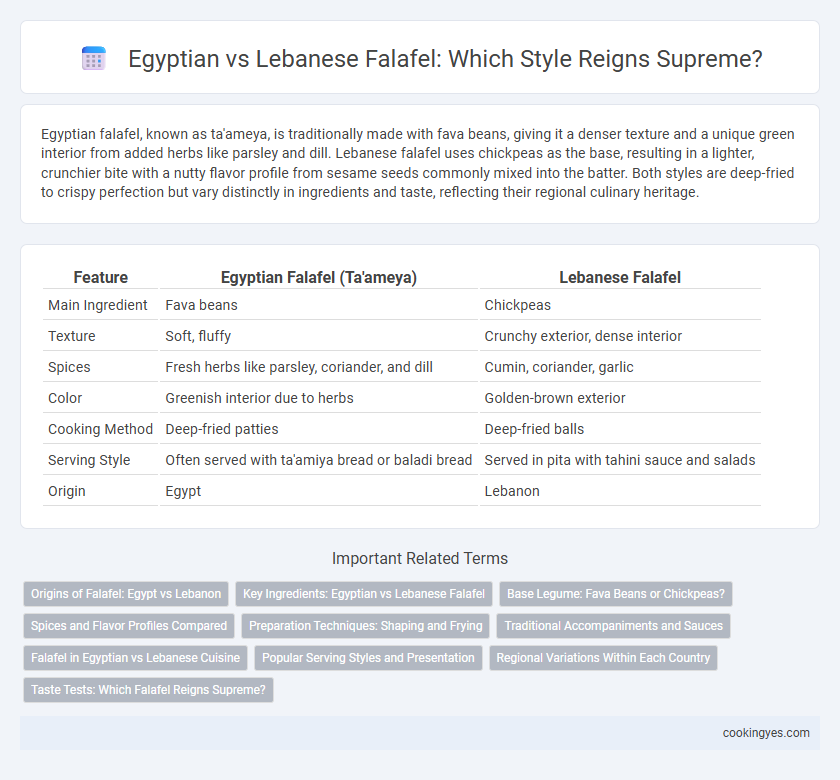Egyptian falafel, known as ta'ameya, is traditionally made with fava beans, giving it a denser texture and a unique green interior from added herbs like parsley and dill. Lebanese falafel uses chickpeas as the base, resulting in a lighter, crunchier bite with a nutty flavor profile from sesame seeds commonly mixed into the batter. Both styles are deep-fried to crispy perfection but vary distinctly in ingredients and taste, reflecting their regional culinary heritage.
Table of Comparison
| Feature | Egyptian Falafel (Ta'ameya) | Lebanese Falafel |
|---|---|---|
| Main Ingredient | Fava beans | Chickpeas |
| Texture | Soft, fluffy | Crunchy exterior, dense interior |
| Spices | Fresh herbs like parsley, coriander, and dill | Cumin, coriander, garlic |
| Color | Greenish interior due to herbs | Golden-brown exterior |
| Cooking Method | Deep-fried patties | Deep-fried balls |
| Serving Style | Often served with ta'amiya bread or baladi bread | Served in pita with tahini sauce and salads |
| Origin | Egypt | Lebanon |
Origins of Falafel: Egypt vs Lebanon
Falafel originated in Egypt, traditionally made from fava beans, reflecting its deep roots in Egyptian street food culture. Lebanese falafel, on the other hand, typically uses chickpeas, highlighting regional adaptation and ingredient availability. The divergence in ingredients illustrates the historical and cultural significance of falafel across Egypt and Lebanon.
Key Ingredients: Egyptian vs Lebanese Falafel
Egyptian falafel, traditionally made from fava beans, incorporates fresh herbs like parsley, cilantro, and dill, lending a bright, earthy flavor. Lebanese falafel primarily uses chickpeas as the base, combined with garlic, cumin, and coriander to create a spiced, aromatic profile. The choice of legume and spice blend defines the distinctive taste and texture differences between Egyptian and Lebanese falafel styles.
Base Legume: Fava Beans or Chickpeas?
Egyptian falafel, known as ta'amiya, is traditionally made using fava beans, lending it a dense texture and rich, earthy flavor unique to the region's culinary heritage. Lebanese falafel primarily utilizes chickpeas, creating a lighter, crispier exterior with a nuttier taste profile favored in Levantine cuisine. The choice of base legume significantly influences the falafel's texture, flavor, and regional authenticity, highlighting the diverse legume use in Middle Eastern cooking traditions.
Spices and Flavor Profiles Compared
Egyptian falafel, traditionally made from fava beans, features bold spices like coriander, cumin, and fresh herbs, resulting in a earthy and herbaceous flavor profile. Lebanese falafel uses chickpeas as a base and incorporates spices such as cumin, garlic, and parsley, creating a slightly nutty and aromatic taste. The Egyptian version tends to be denser and more spiced, while Lebanese falafel offers a lighter texture with a balanced blend of savory and fresh flavors.
Preparation Techniques: Shaping and Frying
Egyptian falafel, traditionally known as taameya, is primarily made from fava beans, shaped into thick patties using a hand-molding technique, which allows a denser texture and crispy exterior when fried. Lebanese falafel uses chickpeas, formed into smaller, round balls or slightly flattened discs, which fry more evenly to produce a lighter, fluffier interior and a crisp outer layer. Both styles rely on deep-frying in hot oil, but Egyptian falafel tends to be fried slightly longer at lower temperatures to ensure thorough cooking without burning, while Lebanese falafel fries quickly at higher heat to lock in moisture and create a golden crust.
Traditional Accompaniments and Sauces
Egyptian falafel, known as ta'amiya, is traditionally made from fava beans and served with accompaniments like tahini sauce, pickled vegetables, and fresh herbs such as parsley and cilantro. Lebanese falafel typically uses chickpeas and is accompanied by garlic sauce (toum), pickles, and tabbouleh, emphasizing a fresh and zesty flavor profile. Both styles highlight distinct traditional sauces and sides that complement their unique ingredients and regional tastes.
Falafel in Egyptian vs Lebanese Cuisine
Egyptian falafel, known as ta'ameya, is traditionally made from fava beans, offering a green interior and a distinct herbaceous flavor profile, whereas Lebanese falafel primarily uses chickpeas, resulting in a golden brown exterior and a nuttier taste. Both styles serve as staples in their respective cuisines, often accompanied by tahini sauce, pickled vegetables, and fresh pita bread. The textural contrast between Egypt's denser falafel and Lebanon's lighter, crispier variety highlights regional legacies in Middle Eastern culinary traditions.
Popular Serving Styles and Presentation
Egyptian falafel, known as ta'ameya, is primarily made from fava beans, resulting in a denser texture and typically served with a side of tahini sauce, pickled vegetables, and flatbread such as baladi. Lebanese falafel uses chickpeas, offering a lighter and crispier bite, often presented in pita pockets filled with fresh salad, pickles, and drizzled with garlic sauce or tahini. Popular serving styles highlight regional ingredients, with Egyptian falafel emphasizing hearty accompaniments and Lebanese falafel favoring vibrant, fresh garnishes for a balanced presentation.
Regional Variations Within Each Country
Egyptian falafel, traditionally called ta'ameya, is primarily made using fava beans, which create a denser, earthier patty distinct from the chickpea-based Lebanese style. In Egypt, regional variations include the addition of herbs like parsley and dill in Cairo, while Upper Egypt favors a spiced mix with coriander and cumin. Lebanese falafel, predominantly chickpea-based, varies by region with northern villages often incorporating pine nuts and broader use of fresh herbs like mint and parsley to enhance freshness and texture.
Taste Tests: Which Falafel Reigns Supreme?
Egyptian falafel, traditionally made with fava beans, offers a creamy, earthy flavor with a slightly nutty undertone, while Lebanese falafel, crafted from chickpeas, delivers a crispier texture and a more herbaceous, vibrant taste. Taste tests often reveal that Egyptian falafel appeals to those who favor a richer, smoother bite, whereas Lebanese falafel satisfies cravings for a lighter, spiced crunch. The preference ultimately hinges on texture and seasoning, with both styles showcasing distinct regional identities in Middle Eastern cuisine.
Egyptian vs Lebanese for Falafel Style Infographic

 cookingyes.com
cookingyes.com